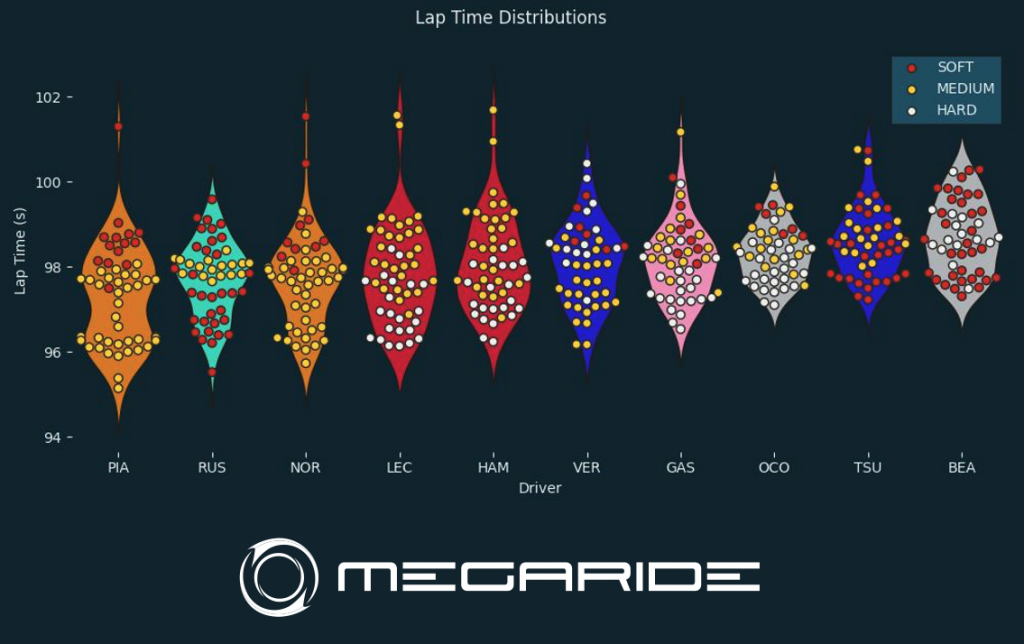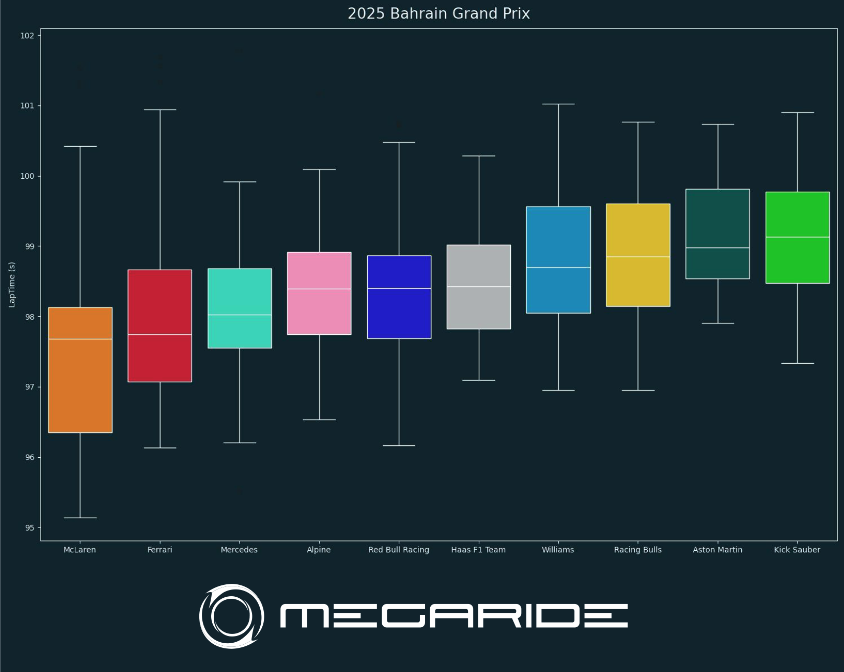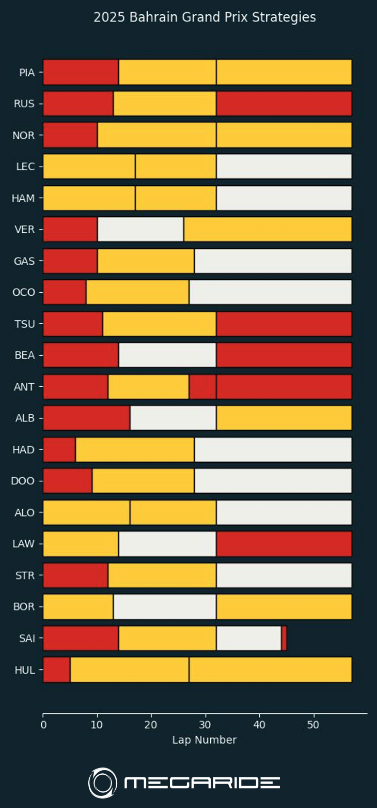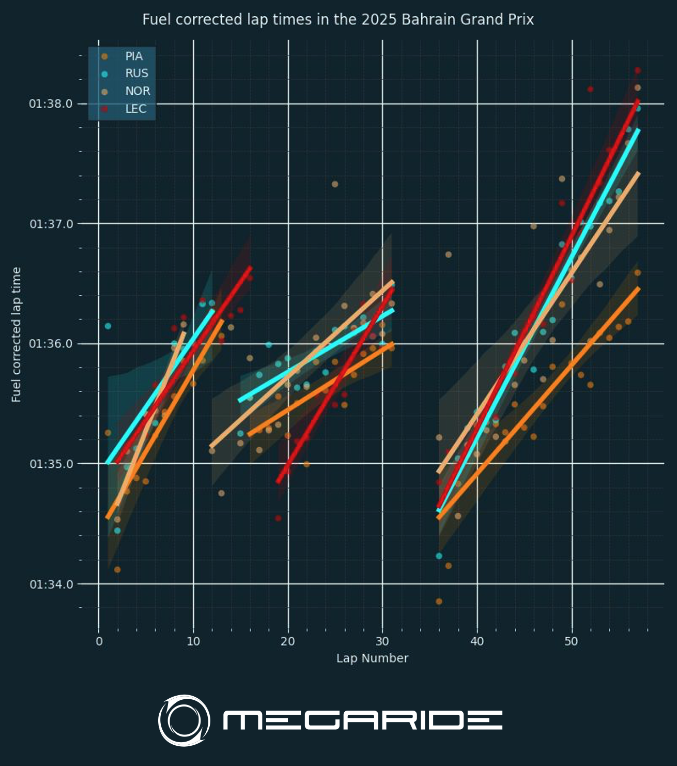
General overview
After last week’s boring race, here is an entertaining and unpredictable Sunday: lots of overtaking, differentiated strategies, and high tire degradation made for a very delightful and enthralling Grand Prix. However, a McLaren won, that of Piastri, accompanied on the podium by Russell, increasingly the Mercedes leader, and Norris, who paid the price for a qualifying not up to the standard of the car he drives. Right behind the two Ferraris of Leclerc and Hamilton, who did not have much pace in the third stint of the race, after the SC entry.
McLaren once again, firmly in first place with pace far behind their rivals, as shown by the ranking chart, which uses error bars to give an idea of the median value and standard deviation of the lap times achieved by the drivers of each team. Ferrari was chasing Mercedes, while Red Bull was in trouble, having a very similar pace to Alpine and Haas.

The race was unpredictable, characterised by very different strategies and varied tire choices. The violin plots were more articulated than usual, but Piastri’s stood out: as constant as a metronome. Norris paid dearly for the start from sixth position and the penalty for incorrect positioning on the grid, only managing to express a pace similar to his teammate’s only at the end, when he was engaged in a fight with Russell. Leclerc had an all in all-in-all positive race, especially in the second stint on medium tires. On hard tires, however, he had a few more problems which affected his poor performance. Russell’s tire management was excellent in the third stint on the soft tire, which he led for a good 24 laps. Hamilton, on the other hand, struggled more, as he was unable to find a rhythm on the hard tires.
Race strategy
Strategies in this race were quite diverse, although most drivers chose to start on soft tires and then switched to medium until the safety car came on. It was this very moment that generated a significant differentiation in the choices for the third stint, with some drivers back on soft, others on medium, and some even on hard. The Ferraris took a different approach: starting on medium tires, the first stint slightly longer and the second stint again on medium. After the safety car, however, they opted for hard tires, as there were still too many laps to go before they could mount the softs – penalised in the previous days by a particularly pronounced degradation. The Mercedes chose to take their chances with the softs in the final stint, while the McLarens went for the medium.

Focus on drivers’ lap times
Piastri’s first stint was extremely consistent, while Norris and Russell showed a slower race pace than the Australian. Leclerc had a fairly solid first stint, with a very similar pace to the front runners and a fairly similar degradation, expressed in increased lap times per lap. With the choice of the harder tire, he extended the first stint by a few laps compared to the others, suggesting a strategic choice towards the end of the race that would have allowed him to use the soft tire with less fuel, very aggressive. In the second stint, Piastri and Russell maintained a similar degradation, while Norris, having brought his stop forward a few laps, began to lose performance towards the end. Leclerc’s stint, on the other hand, was excellent as he delayed his stop and changed to medium tires, managing to overtake Norris and close the gap on Russell. However, he began to lose pace in the final laps. The safety car penalised Leclerc: Ferrari, initially going for a rather aggressive strategy with a possible third stint on soft tires, was forced to change plans. After the entry of the SC, the number of remaining laps was too high to risk the softs, so the hard tire was chosen, but it did not perform well. The Monegasque’s third stint was the most difficult, and his performance suffered. In the final stint, Norris and Russell once again found themselves on very similar rhythms, confirming Russell’s excellent tire management on the softs. Piastri, on the other hand, completed the race fluently, confirming great consistency.

Conclusions
Attention now shifts to Jeddah, the last leg of this hat-trick of races in three weeks. Here too it will be run at night, but the context will be very different: a street circuit, much less technical and treacherous than in Bahrain, and much less severe on the tires both for thermal degradation and abrasion.